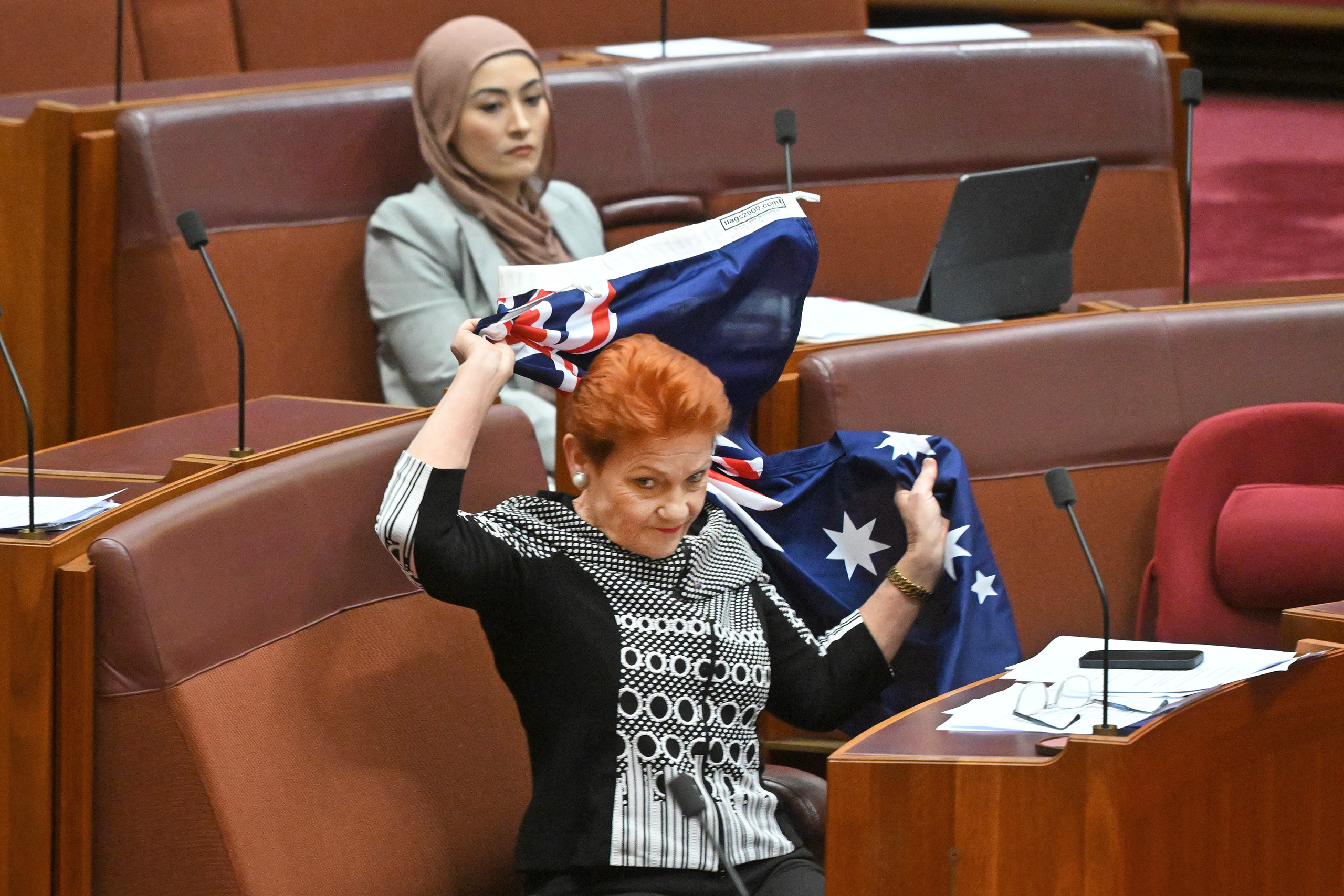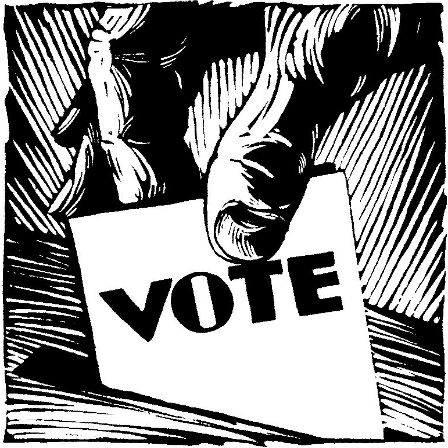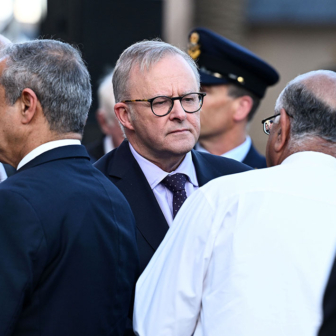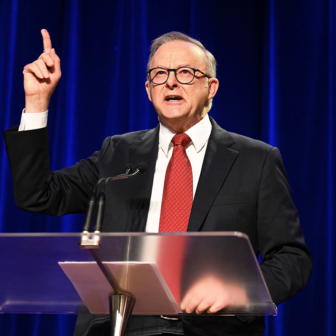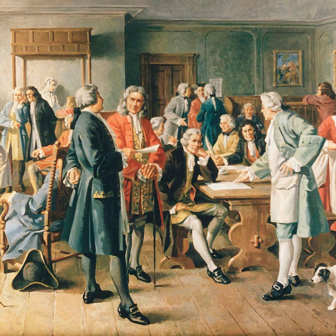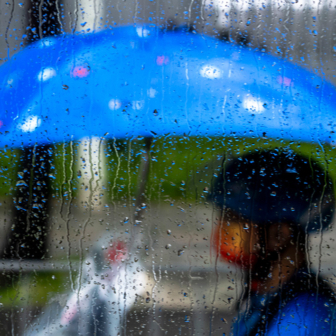One Nation is surging in the opinion polls. By the party’s recent standards that is, and by recent Australian standards to be exact. Back in 1998, One Nation 1.0 enjoyed similar surveyed support for a while, and its actual vote at that year’s federal election remains its highest to date: 8.4 per cent nationally and 14.4 in Queensland.
This month’s numbers, averaging around 11 or 12 per cent, are also nothing like some far-right parties in Europe, the highest-profile from this distance being Reform in Britain and France’s National Rally bloc, both on around 30 per cent and comfortably in the lead, and Germany’s AfD, in the mid-to-high 20s, sometimes leading the pack, sometimes behind the governing CDU.
In Italy, meanwhile, the far-right Georgia Meloni is actually prime minister, and in other countries similar parties sit in governing coalitions.
One Nation is not remotely within distance of those parties. But a couple of recent polls have them slightly ahead of the Greens (Resolve has 12 per cent, Essential 13) and hence in third place. (Essential stubbornly persists with its slightly insane post-2019 policy of not publishing data net of undecideds; there’s a better than even chance that the 13 is really a 14.)
Pollsters are probably overstating the party’s support. When taking their mid-term voting-intention surveys they must decide whether to include a minor party in the same breath as the major ones, or leave it to a secondary list along with the ones you might not have heard of. The first strategy tends to overstate support for the small party, the second tends to understate it. These days the Greens and One Nation always feature in the first list, which is why both go on to underperform at the ballot box. (The Greens less in recent years.)
At this year’s federal election, for example, One Nation received 6.4 per cent in the lower house, a couple of points below what most of the final surveys had suggested.
One reason for the party’s apparent doubling in support since the election might be that the Liberal Party is now led by a “centrist,” even if she’s obliged not to behave like one. Perhaps Peter Dutton, with his regular forays into immigration, racially tinged rhetoric and fierce opposition to the Voice, kept a few potential Hansonites in his tent. Last month’s March for Australia might also have galvanised some people to prioritise immigration when participating in surveys.
But why hasn’t One Nation reached the heights of similar parties in Europe? And more generally, why doesn’t Australia exhibit similar levels of “populism” to Europe and America? Total support for far-right minor parties at this year’s election barely cracked 10 per cent.
I reckon uncontrolled immigration is a major factor in our outlier status: we have virtually zero. Even when “the boats” peaked under the Rudd and Gillard governments, the numbers as a proportion of our population were minuscule compared with what other advanced democracies experience today. In Europe and the United States the huge numbers of “illegals” can be evidenced in many camps, streets and, infamously, hotels, while over here they only appeared on television news.
Electoral systems are a factor, too. With some exceptions, chief among them France and Britain, European countries tend to elect their lower (or sole) chambers via a form of proportional representation. Under such a system down under, Hanson’s party would probably have got a foothold in the House of Representatives in both 1998 and 2016 — as they did in the PR-elected Senate at those elections — and might have played a role in deciding who formed government. From little things big things have been known to grow, although One Nation’s record of losing senators needs to be taken account of. On the other hand, both Britain’s Reform and France’s National Rally managed to overcome the single-member-district hurdle.
There’s the persona of Hanson herself. It’s very likely that in the late 1990s and early noughties her unpolished inarticulateness played a big role in her rise, contrasting with the slickness of those “elites” and the “establishment” who — in her supporters’ view — ridiculed and looked down on her, and hence on them. But perhaps that shtick can only get you so far.
The successful European far-right leaders, according to reports, tend to have the gift of the gab. (I’m monolingual so can only judge Farage, who certainly does.) Many have university degrees and some were born into privilege. In America of course, where the far right has hijacked the major centre-right party, Donald Trump’s undoubted communication skills and outsized personality have been key.
Also in the United States the highly decentralised, partisan-infused, ramshackle election apparatus provided fertile soil for Trump to succeed in persuading some people of his false claims about the 2020 election. In Europe, trust in elections seems to vary. Norway, where it seems to remain high (I couldn’t find any surveys) has nonetheless taken preemptive measures to increase transparency and guard against potential future disinformation campaigns. Australia should do the same.
Our Australian Electoral Commission and its state and territory counterparts deservedly enjoy wide support. Not only do they have legislated statutory independence, but the AEC is most unusual in conducting all aspects of elections. (In most countries, local government plays a major role.)
But our Achilles heel is our voting system, which is widely misunderstood. The intricacies of electing senators are unfathomable for nearly all Australians, though the identity of the government is not decided in that chamber, and the roughly proportional votes-to-seats results do make sense.
It’s the “alternative vote” in the lower house — the thing we call preferential voting — that provides scope for mischief now that major party support is so low. Most Australians probably don’t understand how it works. No data exists for this, but anecdotally many people believe parties “give” each other preferences (as actually was the case for the Senate from 1984 to 2014); journalists’ jargon, which often implies this, is largely to blame. Others assume a second preference has less value than a first, or don’t understand why it doesn’t. Many questioned how Labor could form government in 2022 despite easily losing the primary vote.
France actually has a very similar system to ours, but it’s conducted on two separate occasions. When, between the first and second rounds of last year’s legislative election, some parties made agreements to selectively withdraw from some electorates so as to not split the anti-National Rally vote — which meant that Le Pen’s party won just a quarter of seats despite topping the first-round vote — most French would have understood what had transpired, not least because they (or at least the two-thirds of registered voters) participated in that second round. Not so with preferential voting.
The fate of National Rally in 2024 is analogous to Hanson’s in the Queensland federal electorate of Blair in 1998. She topped the primary vote but failed to win because Labor voters overwhelming preferenced the Liberal candidate thanks to Labor’s how-to-vote cards and general advocacy. Not surprisingly, the result fuelled conspiracy theories among her supporters that can still be heard today; Hanson herself, in her 2016 comeback speech, falsely claimed that “the introduction of full preferential voting… cost me the seat.” Full preferential voting has been with us federally since 1918.
One day a wilier, more articulate far-right politician might emerge who is also a dab hand at spreading dangerous porkies. They might even, as in the United States, come through a major party; Dutton showed he was at least willing to try to spread untruths about electoral shenanigans during the Voice referendum campaign. Our much-misunderstood method of electing members to the House of Representatives (and its counterpart lower houses across the mainland) is a big juicy target.
Some will say the answer is education, but that’s been tried forever. Journalists can’t change their spots. The answer instead is to change the electoral system, preferably to proportional representation (for other reasons as well, and despite any uncomfortable European experiences) or, failing that, to an actual two-round vote.
We do not know what delights America and the rest of the world will throw at us in coming years. But like Norway’s, our legislators and electoral commissions should try to anticipate possible future enablers of widely believed disinformation about how MPs are elected, and build appropriate safeguards. •
